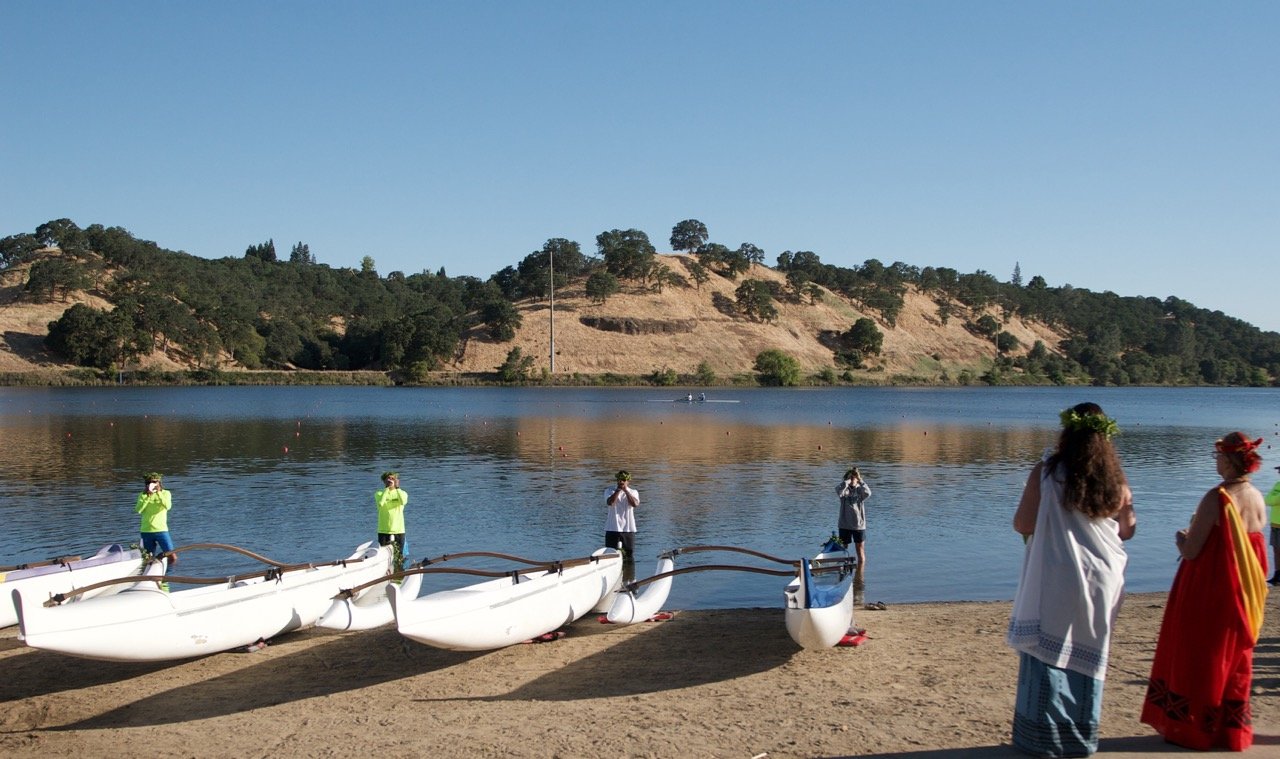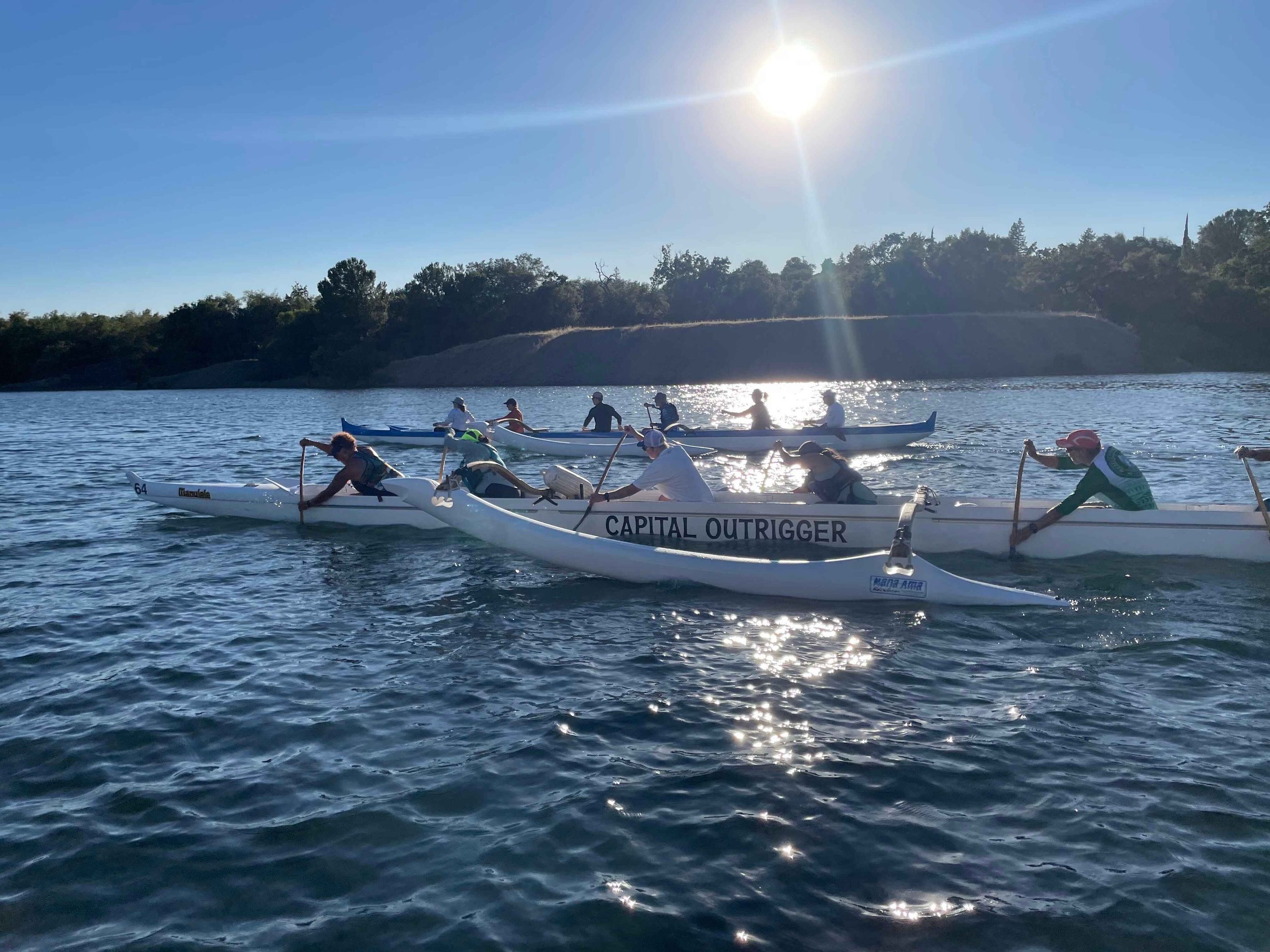
New Paddler Resources
New to outrigger paddling?
Check out our Introduction to Outrigger Paddling!
(Scroll to read the latest version, or download by clicking the button.)
Intro to Outrigger Paddling Guide
Welcome to the world of outrigger canoeing!
This manual is an introductory guide for beginner paddlers just getting started.
Here’s what we’ll cover:
Types of Canoes
Respect and Tradition
Parts of OC6
All about Paddles
The Stroke
Seats and Responsibilities
Calls/Commands
What’s Next
Types of Outrigger Canoes
-

OC-1
-

OC-2
-

OC-6
Traditional Canoes: Ranging from 39’6” to 45’ in length and approximately 400 lbs.
Malia: The original California canoe designed in the 1970s.
Bradley: Developed in the 1980s.
Mirage: A contemporary design spec canoe.
Unlimited: Lighter canoes weighing around 175 lbs.
Respect and Tradition
Outrigger canoes, known as Wa’a (pronounced Va’a), are treated with respect and care.
Nicknames:
• Nai’a (Malia built by Whitey Harrison)
• Manu (Bradley)
• ‘Uhane (Bradley)
• Koa (Mirage)
Care Guidelines:
• Clean and organize canoes before and after practice.
• Walk around, not over, the canoe.
• Always enter from the ama (outrigger) side and lean left.
Parts of an Outrigger Canoe
Image from Pa’a Pono Miloli’i
Paddles
Composition:
All wood
Hybrid
Composite
Types:
Straight shaft
Double bend
Sizing:
Paddles are sized for each paddler, including specialized steering blades. Resource: How to Size Your Paddle
Paddle with the bend in the blade facing forward.
Ready to Purchase a Paddle?
Here are some places you might look:
Fast & Cheap(ish) - ZJ Paddles
Secondary Market - FB Outrigger - Dragon Boat Paddler Buy, Swap and Sell
Primary Market
The Stroke
Paddling in an outrigger canoe requires synchronization and technique over individual exertion. The stroke can be broken down into six key phases:
1. Set Up:
Comfortable extension before blade entry.
One leg forward, the other bent at the knee.
Sit forward on the seat and brace.
2. Entry:
Paddle blade should be at a 45-degree angle to the water and perpendicular to the canoe.
Shaft should be vertical with minimal noise (no cavitation).
3. Catch:
Critical phase; ensure the blade is fully loaded before pulling.
4. Power Phase:
Rotate the body using large muscle groups.
Push off the forward foot for leverage.
5. Exit:
End the pull at mid-thigh.
Remove the paddle at the hip.
6. Recovery:
Return to the setup position in a straight shot.
Key Points
Stay silent in the water.
Pull the canoe to the paddle.
Maintain a rhythm of two beats in the water and one on the return.
Intro to The Stroke
Seats and Responsibilities
Setting the Pace
Seat 1 (also known as a “stroker”) sits in the very front seat of the canoe. Seats 1 and 2 are primarily concerned with ensuring the rhythm and pace of the paddle strokes, which Seats 3-5 follow. They paddle on opposite sides and as such neither has a paddle to follow. A good stroker should be able to adjust the stroke depending on the length of a race or to allow for variable water and wind conditions.
Seat 2 must follow in perfect time, mirroring the stroke pace so that the power distribution remains equal and synchronized down the length of the canoe. When rounding markers, Seats 1 and 2 work together to turn the front of the canoe.
Calling the Changes
Depending on the crew, either Seat 2 or 3 calls the changes, which mark the paddlers changing the side of the canoe on which they paddle. It is important that other than calling the changes, there is no talking in the canoe so that everyone can hear the changes or essential commands from the steersperson.
The Engine Room
Seats 3 & 4 – Often referred to as Power Seats, the heavier, stronger paddlers will generally take these positions. It is their primary task to provide the brute power required to push the canoe along. Seat 4 generally takes responsibility for ensuring the canoe remains as dry as possible, bailing when needed.
Seat 5 – Seat 5 is also a power seat but also needs to have knowledge of steering to assist the steersperson when necessary. They are also referred to as the keeper of the ama. This entails that they must eyeball the ama (the outer float) to make sure it is stable. If it looks at any time to be lifting threatening a huli, they must quickly react to save it. Failing this, Seats 3 and 4 need to recognize the predicament and also try to save the canoe from going over. Seat 5 must also take responsibility for bailing if required should there be an excess of water in the canoe.
Steering
Seat 6 – The steersperson, who is the captain of the canoe, calls the shots, motivates the crew and sets the canoe up for the best coarse and catching the swells. They plan and navigate a course and have a big responsibility during sprint races, where they must set the canoe up for a good turn around the buoys. They need to have a good paddling relationship with Seat 5 in protecting the ama and indeed with all the crew. Steering a 40ft plus canoe on the open ocean in rough water is an art form. Those that learn their trade well can be considered masters of a task, which requires intimate understanding of the dynamics of the ocean and the nuances of the canoe and crew.
Commands
• Paddlers alternate sides (Seat 1 starts on the left).
• Caller Commands:
• Hut: Crew takes one more stroke.
• Hoe: Crew switches sides after calling back.
• Usually 15 strokes per side (hut called on stroke 14).
• Other Commands:
• Paddles up: Ready position or stop paddling.
• Huki: Start paddling.
• Imua: Paddle forward slowly.
• Lava: Stop.

Where to go from here
After completing the Introduction to Paddling Course, you are free to paddle with our recreational and novice groups.
Monday, Wednesday, and Friday at 9 am (8 am in the summer)
Tues/Thurs evenings at 6 pm.
After a few sessions, you can join our Kai ‘Olu program or paddle with the evening group.
We have a great novice program to get started with racing. Please talk to your coach for details.





